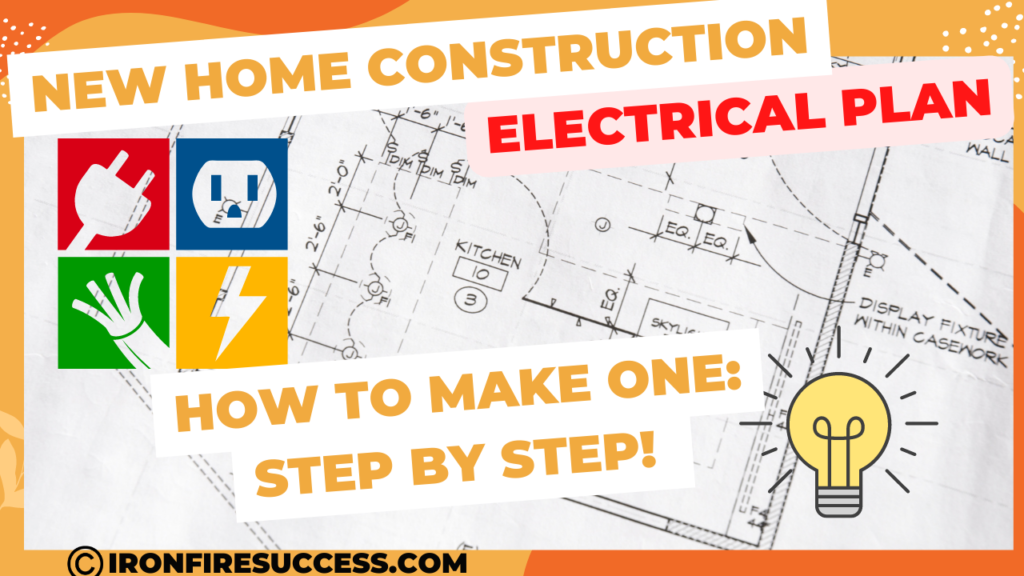The electrical plan is a critical element of your new construction home plan. When most people think of building a new construction home, they focus on the floor plan. However, the electrical plan brings that floor plan to life. The electrical plan forms the foundation for how you and your family will navigate that floor plan. If you are building a new construction home, you should understand what an electrical plan is, see your home’s electrical plan, and know how to make one.
What is an Electrical Plan and How Do You Make One?
What is an Electrical Plan?
The electrical plan is a version of your floor plan that shows the electrical details for the home. It is sometimes referred to as a wiring diagram because it shows the placement of all of your home’s electrical elements and the wiring connections. The home’s electrical elements are things such as lighting, fans, outlets, and switches. You may or may not need to create an electrical plan for your new construction home. However, you should always know what it is, and how to make one so that you can make informed decisions about your new home’s electrical needs.
If you are building a home from a builder’s floor plan, there is probably already an electrical plan for the home. However, if you are building a custom home, you will likely need to work with the builder to create an electrical plan because that exact home has never been built before. Even if you don’t have to make an electrical plan, at a minimum, you should ask to see it. You should also understand how to make an electrical plan so that you can make informed decisions about your lighting and electrical wiring needs at your design center appointment.
Ask to See Your New Construction Home Electrical Plan
Before making any decisions about electrical needs, ask your builder to see your new construction home electrical plan. It will show the placement of electrical elements such as lights (indoors and outdoors), fans, switches, and outlets. It will have markings – usually dotted lines – to show the path of switches that control certain lights. Besides positions of outlets, lighting and wiring for switches, it will also take into account electrical needs such as fans, appliances, hvac, security wiring, and voltage capacity for the home. The electrical plan has markings to symbolize each electrical element, and will have a legend to explain the markings so you know what each item is.
How to Make an Electrical Plan for your New Construction Home
Whether your builder has an electrical plan, or you need to make one, it is a good idea to understand how to make one. Here’s how you make an electrical plan for your new construction home. If you want to see how this is done, check out our YouTube video. In future YouTube videos we discuss how to prepare for your low voltage meeting, and we share our electrical and low voltage upgrade choices for our custom new construction home.
1. Get a copy of your home’s electrical plan (if there is one) and floor plan.
2. Make a list of the electrical items the builder includes in your new construction home
Some typical things a builder may include as “standard” lighting for your new construction home electrical plan:
Ceiling Lights – what kind of ceiling lighting (led flush mounted, recessed can), the amount and type of lighting in each room
Ceiling Fans – how many, and do the ceiling fans have lights
Floor Plugs – number of floor plugs and location
Outside Lights – number of outside lights and location
Doorbell – what kind of system.
Low Voltage (pre-wiring for cable, ethernet, speakers and security systems).
3. Using Your Floor Plan, Draw the Location of Lights and Ceiling Fans Inside and Outside the Home
Starting with the entryway, go room by room and think of how much light you will need. Often, bedrooms and offices could benefit from additional lighting. Also, don’t forget to ensure hallways are well lit. Draw a circle on your floor plan anywhere you want lighting and mark where you want a fan. Then do the same thing for the outside of your house, front and back. Don’t forget places like the attic or the garage. Also, consider future electrical and lighting needs so you can do the pre-wiring now. Think about specialty or additional types of lighting and visit model homes to get ideas:
Led flushmount lights instead of recessed cans. Led flushmount lights are less expensive and energy efficient. However, you may need to put recessed cans in wet areas like showers.
Closet Lights – is there enough light in walk-in closets? Do you want a motion sensor in a closet, your pantry or utility room?
Pendant Lights – these are nice to provide focused light on certain areas like over a kitchen island, the bathroom mirror or even bedside.
Chandeliers – great for entryways, foyers and over the tub in the owner’s suite bathroom.
Hallways – is there enough overhead lighting in the hallway? Also consider sconce lighting on the walls in a hallway.
Picture Lights – great for showing off artwork and giving a dramatic spotlight.
Wall Sconces – these can be used anywhere inside or outside of the home. Sconces can be great in media rooms, hallways, offices and also frame a mirror in a bathroom, or provide light over shelves. Sconce lighting can also be a great lighting option for a patio or on the front of the house.
Ceiling Fans – where do you want a ceiling fan inside the home or outside under a covered patio? Make sure you tell the builder where you want to pre-wire for a fan to ensure that the weight of the fan is taken into consideration during the build.
Outdoor kitchens/pools/hot tubs – tell the builder if you plan to do any of these things in the future to ensure the electrical plan takes these things into consideration for the home’s electrical load capacity and pre-wire.
You do not have to purchase pendant lights, chandeliers, sconces or ceiling fans from the builder. However, having these areas pre-wired will save you time, stress and money in the future.
4. Draw the Location of the Switches to Control Those Lights and Fans
Using your floor plan, do a walkthrough of your home. Start with the entry points such as the garage and front door. Consider where you want to place switches to turn on overhead lights as you enter the house? Where will you turn off the lights behind you? Open floor plans mean less walls, which means farther distance to get to switches. Make sure you don’t have to walk backwards across rooms to turn off lights. It is a good idea to put switches on either end of large rooms and hallways.
Also, if you plan to have a ceiling fan with a light in it, consider having the light and fan on separate switches (even if you will have a remote control). Don’t forget your outdoor Living Spaces that may also need ceiling lights, ceiling fans, wall sconces,, and consider any future outdoor kitchen electrical needs. Consider placement of switches to independently control patio lights and fans conveniently located near entry points to patio. Draw a dotted line from the light or fan to the switch that will control it. This will show whether you will need a single, double, triple or quadruple switch in a particular area.
5. Draw the Location of Specific Additional Outlets
The builder will include outlets in your new construction electrical plan as per code. That means you will automatically have outlets in certain places, spaced a certain distance apart. However, you may want to add outlets in specific places for convenience.
For instance, you may consider adding outlets inside of your pantry, utility room closet or bedroom walk-in closet to charge or operate small appliances. Open Floor plans mean less walls, which means farther distance to wall outlets. Floor outlets are a great solution. Also, less wall space for wall units, bookcases or TV stands. TVs are more likely to be hung on the best available wall in a room. Adding an outlet to the TV wall will prevent cords from hanging down behind a wall mounted TV. Don’t forget to consider outlets outside of your home, like in front of your home, soffit outlets and patio ceiling outlets for holiday lights, and outlets for mounted TVs on the patio.
Remember, you don’t need to purchase the lights or fans from the builder, but pre-wiring will save you time, stress and money in the future. Watch our YouTube videos where we show you how to make an electrical plan, how to prepare for your low voltage meeting, and we share our electrical and low voltage upgrade choices.
Best Wishes on Your Success Journey!





